| enter keyword to search: |
|
Images db
|
|
|
Articles db
|
|
|
|
|
|
|
|
|
Surya the Sun god is one of the most important Vedic deity and numerous temples were dedicated to Sun god all over India. The celebrated Konark Temple or Black Pagoda (alternative spelling Konarak, Konarka) was constructed in the xiii century in the form of a chariot on 24 wheels drawn by seven horses.
This temple is one of the greatest achievement of Hindu architecture and in the same time it is the demonstration of its very limits. The project was so bold that the temple started to decay soon after its construction, and possibly it was never completed. The stone used, the khondalite prone to easy weathering, has been one of the major cause in its gradual disintegration. There is no pictorial evidence of a standing deul and moreover ten-metre iron beams were necessary to support the immense jagamohana roof. When the temple was known to English colonialists the jagamohan was already filled with stones and debris to avoid the collapse, and today it is still in this condition. For centuries the temple remained covered by the sand and its sculptures were plundered by a local Raja or shipped off to the museums of Delhi, Calcutta and London. The stone pillar crowned with an image of Aruna, Surya's charioteer, that stood in front of the main door, today stands in front of the eastern gateway of the Jagannath temple in Puri. Today the temple is run by Archaeological Survey of India (ASI) and it is set in a gardened fenced area, maybe not a very picturesque setting but it allows tourists to visit comfortably the temple, the majority of whom are attracted by the amazingly elaborate sculptures of the temple platform and, above all, the infamous erotica.
UNESCO has declared the temple a World Heritage Site.
|
Konark |
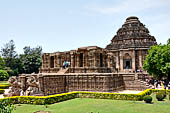
|
Inside a walled enclosure, the temple compound is composed by various elements.
The 'hall of offerings' (bhoga mandapa) is also called nata-mandir (hall of dancers) because of the musicians and dancers which decorate its platform and its stocky pillars suggesting that it must have been used for the devadasi ritual dance. The now roofless pillared-hall is isolated from the main shrine and it is erected on a high platform like the jagamohana-deul complex. The decoration of the platform is divided in three horizontal bands and it is composed by miniature temples flanked by female figures and virala motifs. The pillared mandapa is built on a low secondary platform accessed by steps. In each side, in correspondence of the monumental stairway, there is a central entrance and two side entrances framed by pillars joined with short walls to the corner pillars, this arrangement makes in total eight pillars per side. Inside four massive square pillars are arranged in square dividing the ground plan in nine squares. Nothing has survived of the roof.
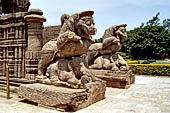
|
Konark
|
The two rampant lions striking elephants that once stood in front of the east entrance of the jagamohan, today guard the entrance of the mandapa.
At the sides of the eastern staircase leading to the main temple entrance there are the seven horses that haul the sun eastwards (only one of the horses is still intact).
The jagamohana-deul complex is built on a richly decorated 4 m high platform. The platform is divided in horizontal layers, the lowest (upana), only few centimetres high, is a continuous frieze which runs all around the base and it is decorated with elephants (more than ten thousands, each different, including wild elephants being trapped, military procession, hunting etc.). The main layer (jangha) is divided in two distinct bands, the lower band is decorated with miniature temples (khakhara mundi) separated by a variety of figures of kanyas and surasundaris in various moods and attitudes, some erotic, and vyala (rampant leonine figure on an elephant). Along the top of the platform, two projecting mouldings shade the lower friezes from the perpendicular rays of the midday fierce Orissan sun. The subjects of the sculptures are taken from the life of the time: hunting scenes, mendicants, ascetics, labourers, soldiers, courtesans, dancers and musicians, erotic enjoyment and the king himself with its royal dignitaries.
The twelve pairs of great wheels arrayed along the platform. The hub and spokes are intricately decorated and sculpted with various figures and motifs: deities, erotic and amorous figures, kanyas, king on elephant, hunting scenes, etc.
Konark |
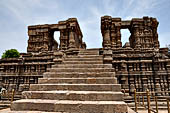
|
The Jagamohan with its impressive pyramidal roof divided into three tiers of projecting cornices. Weird life size statues, mostly of musicians and dancers guard from the roof tiers.
The eastern doorframe is the only one that is still well preserved, the doorjamb of chlorite stone is decorated in low relief with naga, kinnaras, meandering creepers, etc. Below a big tree just after the site entrance there are other chlorite fragments of the doorframes.
The north staircase leading to the jagamohan is guarded by a pair of elephants statues. While the south staircase is guarded by a pair of war horses.
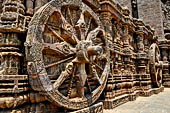
|
Konark
|
Among the extant remains of the tower there are three remarkable green chlorite statues of Surya. On the southern niche Surya is over a chariot drawn by seven horses with all the paraphernalia including his four wives, Rajni, Nikshubha, Chhaya and Suvarchasa and the two divinities Usha and Pratyusha, dispelling the darkness by shooting arrows. The temple presiding deity has been moved into the Jagannath temple of Puri. Three dikpalas (Agni, Yama and Nirriti) are today in the Museum.
Konark |
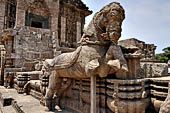
|
In the southwest corner of the compound there is the Mayadevi temple (formerly dedicated to Chaya, the goddess of the shadow, one of the Surya's wifes). The temple is stylistically and ichnographically identical to the main temple.
Outside the compound there is the archaeological museum where some little interesting pieces are displayed. Of more interest is the stone architrave inside the small temple of the nine planets and kept as a living shrine, this Navagrahas slab was originally placed above one of the temple doorways. The nine planets are worshipped for rain, peace and prosperity, long life and nourishment, and for revenge. Saturn is identified by a water pot in his hand.
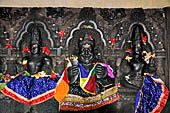
|
Konark
|
|
Related Pages
††-
††-
††-
††
|
|
|
 |
|
|



